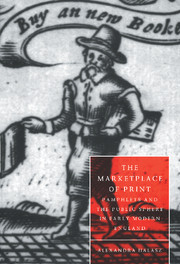Afterword
Published online by Cambridge University Press: 10 December 2009
Summary
In the sixteenth century “commodity” was an attribute, a quality of convenience, capability, advantage that might inhere in or be imputed to objects and opportunities alike. The technology of print afforded such an opportunity, a convenient means of reproducing and disseminating discourse. In the case of pamphlets, we can trace the process whereby commodity comes to describe not attributes of an object but the object itself, along with the misrecognitions that result. However unstable the boundary between pamphlet and book, the extended availability of such a distinction has shaped our understanding of print. The great ages of political pamphleteering did not so much undo that distinction as affirm it by providing the exception that proved the rule. “The actual number of modern pamphlets is very large,” Orwell writes, “but they are poor things, not much read and seldom deserving to be read … describing a short parabola from printing press to waste-paper basket” (16). Making certain pamphlets into rich things, honorary books, elides the proliferation of print in order to reinforce one of its mythic dimensions, an association with democratic institutions. But the ambivalence of proliferation remains, both in the sense that most of the products of the press are indeed destined for waste paper, and in what might be called an Orwellian sense that proliferation can as easily work against democratic goals. In rethinking the case of “pamphlet” – a commodity-discourse characterized by an imputed ephemerality and the implied publicity of a circulation not necessarily tethered to traditional sites of discursive production and authority – the sixteenth-century sense of commodity reemerges as an attribute of (the) technology, the objects it creates, and the opportunities it can be made to shape.
- Type
- Chapter
- Information
- The Marketplace of PrintPamphlets and the Public Sphere in Early Modern England, pp. 204 - 206Publisher: Cambridge University PressPrint publication year: 1997



